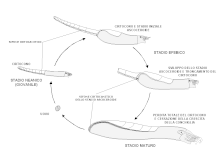
Nautiloids are a group of marine cephalopods (Mollusca) which originated in the Late Cambrian and are represented today by the living Nautilus and Allonautilus. Fossil nautiloids are diverse and speciose, with over 2,500 recorded species. They flourished during the early Paleozoic era, when they constituted the main predatory animals. Early in their evolution, nautiloids developed an extraordinary diversity of shell shapes, including coiled morphologies and giant straight-shelled forms (orthocones). Only a handful of rare coiled species, the nautiluses, survive to the present day.
Cameroceras is an extinct genus of endocerid cephalopod which lived in equatorial oceans during the entire Ordovician period. Like other endocerids, it was an orthocone, meaning that its shell was fairly straight and pointed. It was particularly abundant and widespread in the Late Ordovician, inhabiting the shallow tropical seas in and around Laurentia, Baltica and Siberia.
Discosorida are an order of cephalopods that lived from the beginning of the Middle Ordovician, through the Silurian, and into the Devonian. Discosorids are unique in the structure and formation of the siphuncle, the tube that runs through and connects the camerae (chambers) in cephalopods, which unlike those in other orders is zoned longitudinally along the segments rather than laterally. Siphuncle structure indicated that the Discosorida evolved directly from the Plectronoceratida rather than through the more developed Ellesmerocerida, as did the other orders. Finally and most diagnostic, discosorids developed a reinforcing, grommet-like structure in the septal opening of the siphuncle known as the bullette, formed by a thickening of the connecting ring as it draped around the folded back septal neck.

Plectronocerida is a primitive order from which subsequent cephalopod orders are ultimately derived.
The Ellesmerocerida is an order of primitive cephalopods belonging to the subclass Nautiloidea with a widespread distribution that lived during the Late Cambrian and Ordovician.

The Oncocerida comprise a diverse group of generally small nautiloid cephalopods known from the Middle Ordovician to the Mississippian, in which the connecting rings are thin and siphuncle segments are variably expanded. At present the order consists of some 16 families, a few of which, such as the Oncoceratidae, Brevicoceratidae, and Acleistoceratidae contain a fair number of genera each while others like the Trimeroceratidae and Archiacoceratidae are represented by only two or three.

Lituitida is an order of orthoceratoid cephalopods. They correspond to the family Lituitidae of the Treatise, reranked as an order and combined with other orthoceratoids. They are considered to be more closely related to the Orthocerida than to the Ascocerida or Pseudorthocerida which are also included.
The Reudemannoceratidae are the ancestral and most primitive of the Discosorida, an order of cephalopods from the early Paleozoic. The Reudemannoceratidae produced generally medium-sized endogastric and almost straight shells with the siphuncle slightly ventral from the center.

Pseudorthocerida is an order of generally straight longiconic orthoceratoids with a subcentral to marginal cyrtochoanitic siphuncle composed of variably expanded segments which may contain internal deposits that may develop into a continuous parietal lining.. Cameral deposits are common and concentrated ventrally. Apices typically have a slight to moderate exogastric curvature
Westonoceras is an extinct nautiloid genus from the Discosorida that lived during the Middle and Late Ordovician that has been found in North America, Greenland, and Northern Europe. It is the type genus for the Westonoceratidae

Oncoceratidae is a family of nauatiloid cephalopods in the order Oncocerida established by Hyatt, 1884, that range from the Middle Ordovician to the Upper Silurian.

The Phragmoceratidae is a family of extinct nautiloid cephalopods from the Order Discosorida that lived during the latter part of the Silurian.

The Armenoceratidae are a family of early Paleozoic nautiloid cephalopods belonging to the order Actinocerida.

Endoceratidae is a family of large to very large straight shelled nautiloid cephalopods belonging to the order Endocerida that lived during the Middle and Late Ordovician. They include the largest known Paleozoic invertebrates, represented by Endoceras and Cameroceras.
Pentameroceras is a straight to slightly exogastric breviconic oncocerid from the middle Silurian of North America and Europe belonging to the Trimeroceratidae.
Poterioceratidae is a family of nautiloid cephalopods included in the Oncocerida that lived during the period from the Early Devonian to the Early Carboniferous (Mississippian). Members of the Poterioceratidae are distinguished by a subcircular to compressed exogastric shell that has no hyponomic sinus and a central to subcentral siphuncle composed of subquadrate to nummuloidal segments in which the septal necks are more strongly curved on the upper, or dorsal side. This is opposite from the Karoceratidae in which siphuncle segments are inflated ventrally but straight dorsally. Some poterioceratid genera have actinosiphonate structures or annular deposits within the siphuncle. In others it is empty.
Ascoceratidae is a family of Ascocerida, bizarre orthoceratoid cephalopods, with longiconic, deciduous early growth stages which undergo period truncation and an inflated breviconic mature ascoceroid stage. The Ascoceratidae are divided into two, unequal subfamilies.
Cyrtogomphoceras is a genus of nautiloid cephalopods, recognized by its large breviconic shell with a notable endogastric curvature. The shell is fusiform in profile, reaching maximum width at or near the base of body chamber, which narrows toward the aperture. The siphuncle is large and slightly removed from the ventral side, that with the concave longitudinal profile. Siphuncle segments are short, as are chambers; septal necks recurved, connecting rings thick, bullettes at the apical end of the rings swollen. Cameral deposits are lacking.
Karoceras is a genus of oncocerid nautiloids that lived during the Silurian and possibly Early Devonian, type genus for the Karoceratidae. The shell is a compressed, exogastric cyrtocone, section sub ovoid. The siphuncle is ventral, near the outer, externally convex curvature. Septal necks flair outwardly, segments are inflated ventrally and are straight dorsally, a character of the family.
Maelonoceras is a Late Ordovician - early Silurian oncocerid found in Ontario.










